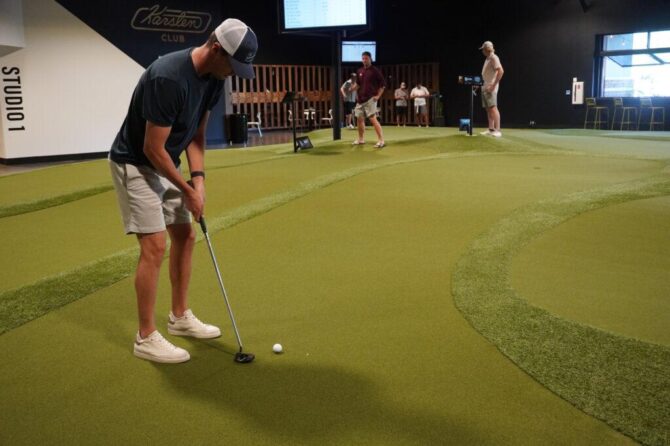The Journey of Mastery in Golf: A comprehensive Past and Analytical Perspective
golf, a sport steeped in tradition, has evolved into a significant cultural phenomenon over the centuries. Emerging in the 15th century from Scotland, it began as a simple game played on natural landscapes with basic clubs and balls. As its popularity surged,golf underwent substantial transformations that reshaped its gameplay and broadened its accessibility. This article delves into the evolution of mastery in golf, tracing its historical roots to modern practices thru an analytical lens.
This exploration highlights key milestones in golf’s advancement—from the establishment of standardized rules and professional tournaments to advancements in technology and training methods. It also examines socio-cultural influences that have affected participation across various demographics, illustrating how golf has shifted from an exclusive pastime to a widely embraced global activity.
By synthesizing historical records with contemporary analysis, this article aims to provide insights into how golfers have pursued excellence throughout different eras. Additionally,it will discuss technological advancements that have transformed both professional play and educational resources available for enthusiasts today. By framing mastery within this broader context, we seek to illuminate golf’s ongoing evolution and significance within the sporting realm.
Historical Context of Golf Mastery: Influential Figures
The origins of golf can be traced back to 15th-century Scotland where players utilized rudimentary equipment on natural terrains.Evolving from ancient stick-and-ball games, early golf held considerable cultural importance that shaped its development over time. The transition from crude beginnings to a structured game with standardized rules laid the foundation for professional competition and modern instruction.
Key figures such as Old Tom Morris and Young Tom Morris were instrumental not only in enhancing golfing skills but also in course design—setting standards for future generations aspiring toward mastery.
The 20th century saw further revolution through influential players like Ben Hogan, celebrated for his contributions to swing mechanics and instructional literature. His renowned book Five Lessons: The Modern Fundamentals of Golf, remains essential reading for aspiring golfers today. Hogan emphasized mastering fundamentals such as grip, stance, and swing plane—critical elements necessary for achieving precision on the course.
| Name of Influencer | Main Contributions |
|---|---|
| Old Tom Morris | Pioneering Course Design & Greenkeeping Techniques |
| Young Tom Morris | Laying Competitive Standards & Practices |
| Ben Hogan | td>Pioneering Instructional Literature & Swing Mechanics |
This historical overview reveals an intricate relationship between individuals’ contributions and the sport’s evolution over time; each new technique or philosophy built upon previous legacies inspires golfers worldwide while honoring traditions established centuries ago.
Exploring Technical Foundations: Golf Swing Mechanics Analysis
The complexities involved in swing mechanics combine physics with biomechanics—a blend crucial for evolving techniques within this sport.main Elements:
- The grip affects clubface angle at impact;
- A stable stance provides balance;
- An efficient posture ensures optimal swing path;
these components work together maximizing energy transfer essential for executing high-quality shots.Recent studies reveal notable biomechanical differences between professionals versus amateurs highlighting elite players’ performance techniques; motion analysis indicates pros maintain consistent angles between arms/clubs during downswing—a vital observation emphasizing synchronized body movement enhances distance/precision.The integration of findings from both historical perspectives alongside current analyses showcases continuous advancement regarding swing mechanics; technologies like motion capture/high-speed video analysis allow deeper examinations supporting customary methods advocated by legends such as Ben Hogan—enabling golfers’ understanding their swings better while improving personal performance contributing towards mastering their craft overall.
Importance Of Practice And Repetition In Developing Skills In Golfing Excellence!
Aiming towards golfing excellence necessitates recognizing practice/repetition’s critical role! To master diverse aspects—from swings down putting strokes—golfers must commit themselves diligently fostering skill retention through consistent efforts leading muscle memory enhancement allowing complex movements performed effortlessly!
Research suggests purposeful repetition characterized by structured approaches breaking learning processes down manageable components accelerates acquisition skills targeting specific deficiencies (driving/chipping/putting). Engaging deliberate practice techniques bolsters mental aspects too emphasizing quality over quantity!
Moreover appropriate duration/intensity during sessions considerably impacts skill growth! Optimal lengths range around thirty-sixty minutes ensuring focused efforts without mental fatigue! Individualized regimens based personal goals further enhance development potential summarized below:
| Practice Activity | Focus Area | </thead<tbody<tr | Driving Range Session | Long Game Mechanics | <tbody<tr | Short Game Drills | Chipping/Pitching | <tbody<tr | Putting Green Routine | Alignment/Speed Control
Impact Of Technological Advancements On Training Techniques In golf!<p>Integrating technology fundamentally transforms how players develop skills understand performances utilizing innovative tools like video analysis software biomechanical assessments leveraging high-speed cameras/motion sensors dissecting player’s swings enabling real-time visualizations precise adjustments fostering comprehension bridging gaps theoretical knowledge practical execution.</P> Additionally smart training aids enhance experiences considerably devices equipped launch monitors feedback sensors providing instant data metrics (swing speed angle attack ball trajectory) invaluable amateurs/professionals refining games tracking progress adjusting routines based concrete feedback rather than subjective feelings guesswork! Looking ahead virtual reality augmented reality technologies shape future training simulating various conditions practicing environments mirroring real-life scenarios gamification engages competitive scenarios motivating sustained engagement promising unprecedented opportunities mastering crafts efficiently effectively! <h2 id=“mental-strategies-for-enhanced-performance”Integrating Mental Strategies For Enhanced Performance In Golf! <p>Bridging physical prowess mental acuity is essential achieving peak performance influencing consistency effectiveness courses adopting techniques enhancing focus managing anxiety maintaining positive mindsets competitions key strategies include:</P>
|
|---|






